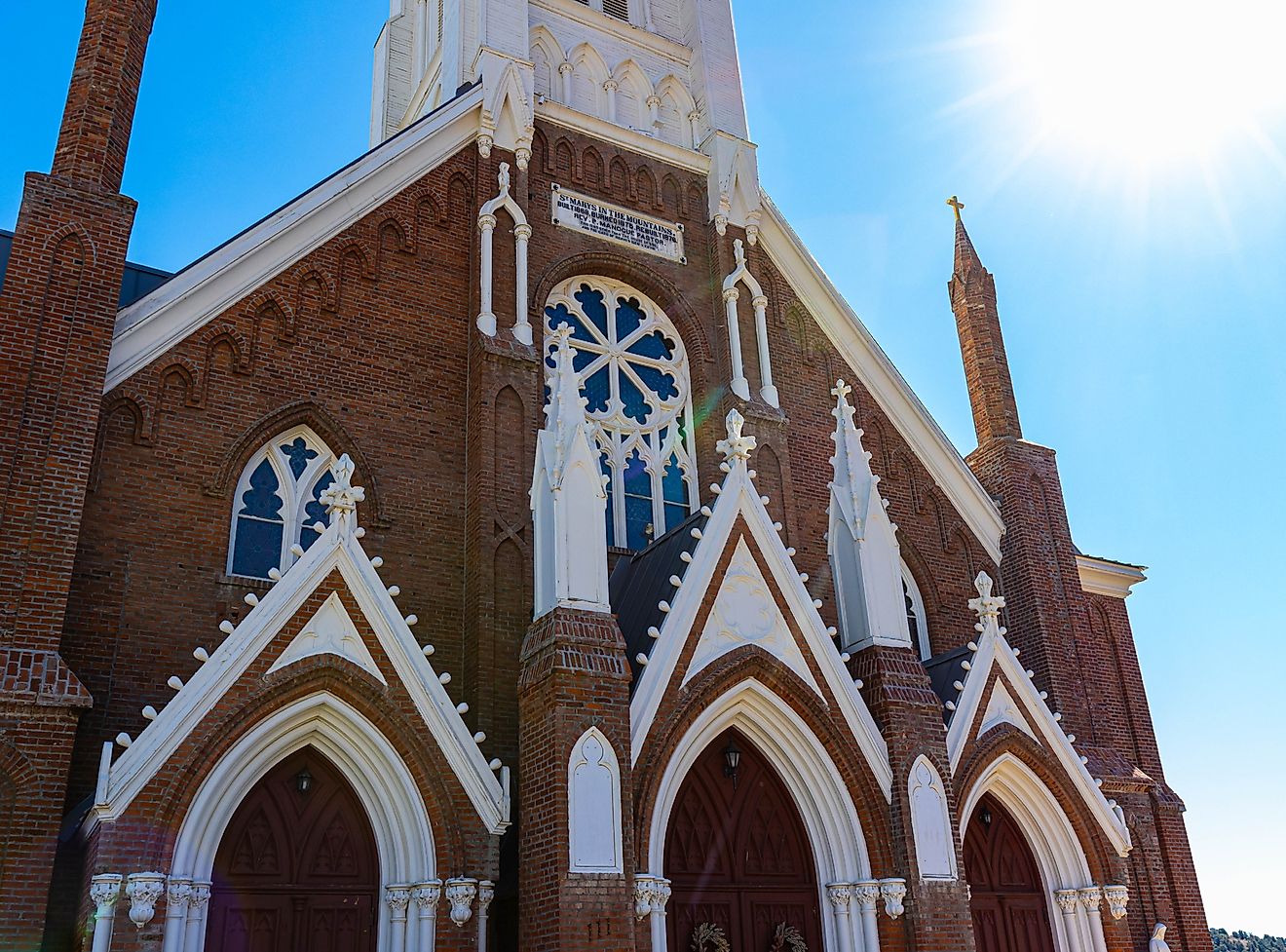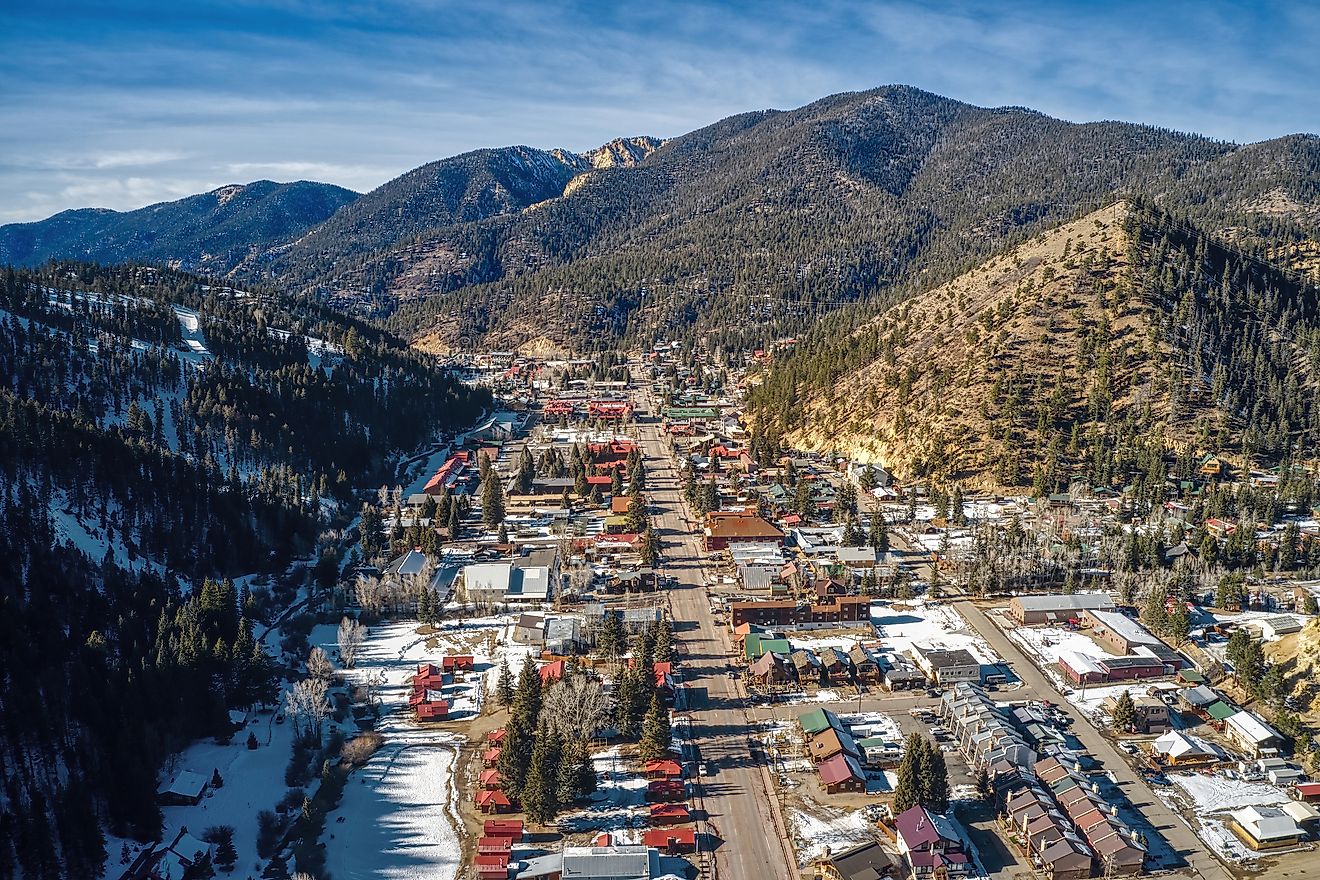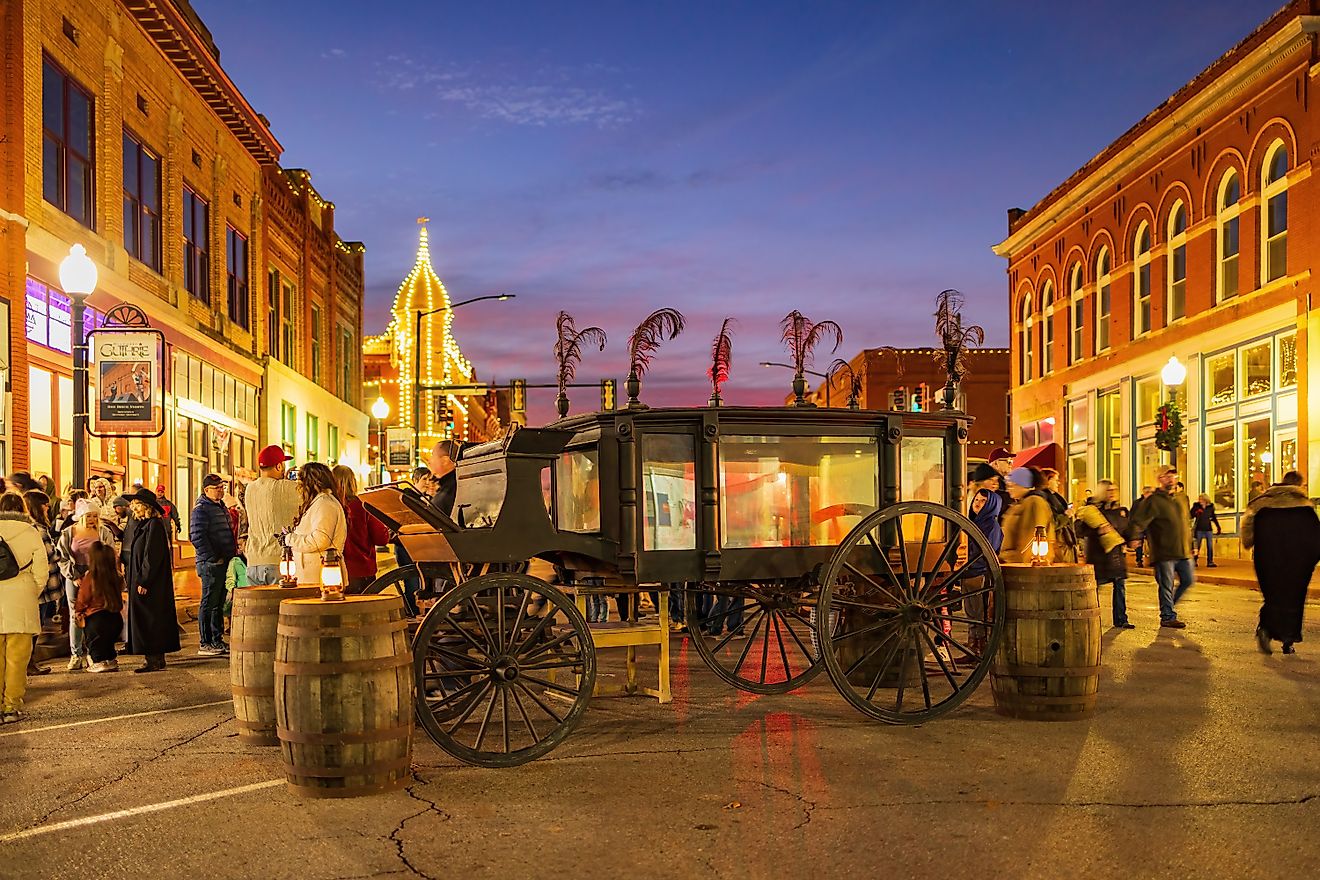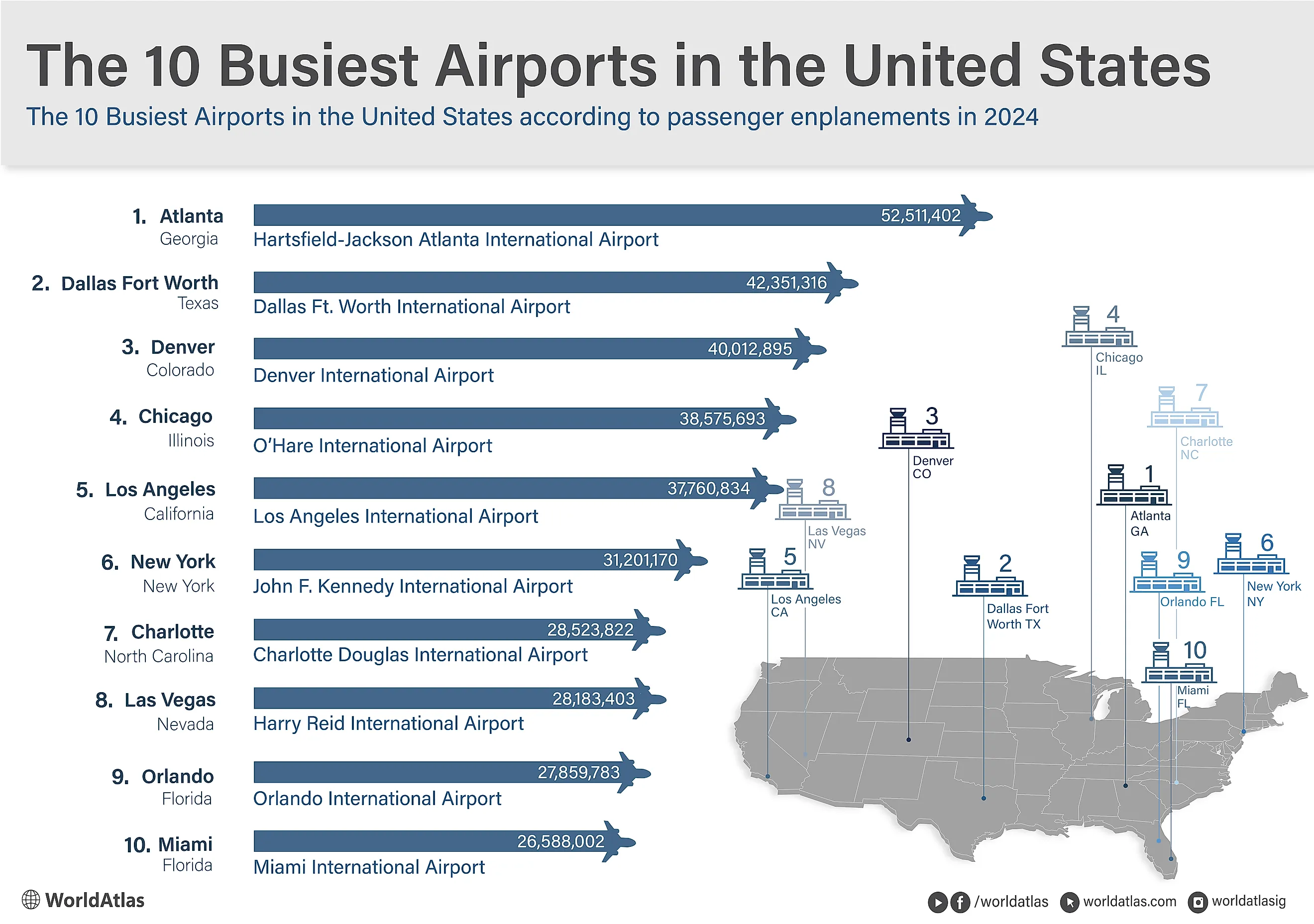
The 10 Busiest Airports In The United States
Airports are vital links in the US transport system, moving people, jobs, and trade. In 2024, the ten busiest hubs handled a combined 618 million boardings, nearly one-third of all US enplanements.
Four mega-hubs (ATL, DFW, DEN, ORD) alone captured almost half of that flow, highlighting the country's highly centralized air network. Yet strong showings from tourist-oriented gateways (LAS, MCO) and a Latin-America connector (MIA) reveal that leisure and international demand now rival traditional domestic hub traffic. The busiest airports in the US based on passenger enplanements are Hartsfield-Jackson Atlanta International Airport, Dallas Fort Worth International Airport, and Denver International Airport, with 52 million, 42 million, and 40 million passengers each, respectively.
The 10 Busiest Airports in the US by Passenger Traffic
| Rank | Airport | Major Cities | State | Passenger Enplanements (2024) |
|---|---|---|---|---|
| 1 | Hartsfield-Jackson Atlanta International Airport | Atlanta | GA | 52,511,402 |
| 2 | Dallas Fort Worth International Airport | Dallas and Fort Worth | TX | 42,351,316 |
| 3 | Denver International Airport | Denver | CO | 40,012,895 |
| 4 | O'Hare International Airport | Chicago | IL | 38,575,693 |
| 5 | Los Angeles International Airport | Los Angeles | CA | 37,760,834 |
| 6 | John F. Kennedy International Airport | New York City | NY | 31,201,170 |
| 7 | Charlotte Douglas International Airport | Charlotte | NC | 28,523,822 |
| 8 | Harry Reid International Airport | Las Vegas | NV | 28,183,403 |
| 9 | Orlando International Airport | Orlando | FL | 27,859,783 |
| 10 | Miami International Airport | Miami | FL | 26,588,002 |
Jump to a list of the 30 busiest airports in the US
1. Hartsfield-Jackson Atlanta International Airport
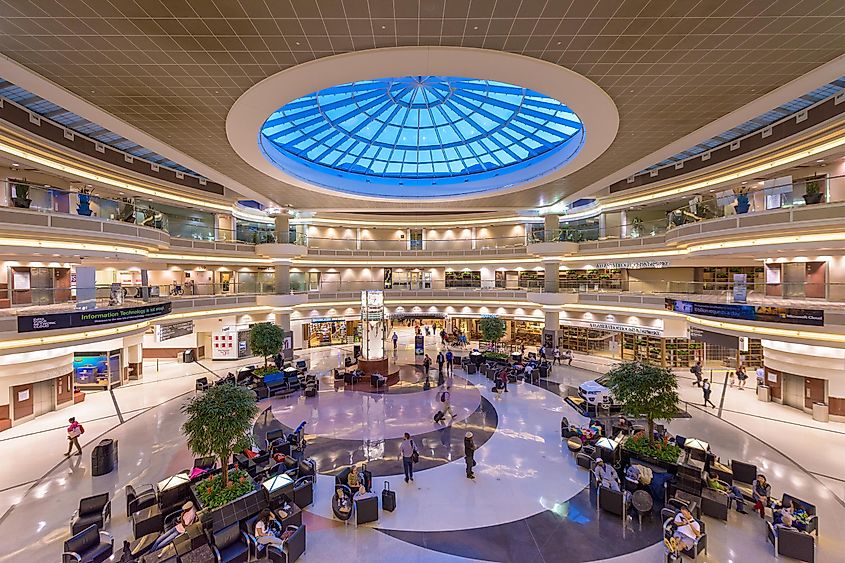
Hartsfield-Jackson Atlanta International Airport (ATL) has ranked as the world's busiest by passenger traffic almost every year since 1998, handling nearly 800,000 aircraft movements in 2024. Ten miles south of downtown Atlanta, the 4,700-acre facility features five parallel runways, including a 12,390-ft A380-capable strip, and two terminals linked to seven concourses and MARTA rail. Delta Air Lines maintains its corporate headquarters and the world's largest airline hub here, operating more than 1,000 daily flights to 225 destinations; Frontier, Southwest, and Spirit also base operations here. Continuous expansions, such as the Maynard H. Jackson International Terminal (2012) and a fifth runway bridging I-285 (2006), enable ATL to serve as Georgia's largest employment center and a critical Southeast logistics portal, global gateway.
2. Dallas Fort Worth International Airport
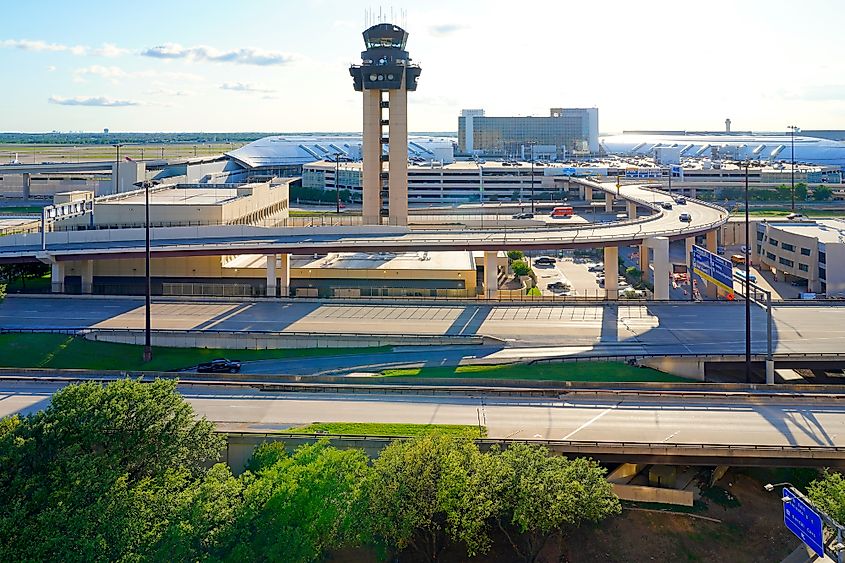
Dallas Fort Worth International Airport (DFW) straddles Dallas and Tarrant counties and, at 17,207 acres, is America's second-largest airport by land area. Opened in 1974, it handled 87.8 million passengers and 743,000 aircraft movements in 2024, ranking third worldwide for movements and second for passengers. American Airlines operates its primary hub here, which accounts for nearly two-thirds of all traffic, while Frontier, Spirit, and UPS also base operations. DFW fields seven parallel runways, four of them 13,400 ft long, giving it unmatched simultaneous-arrival capacity. Six semicircular terminals (A-E plus the new 31-gate Terminal F opening in 2027) are linked by the high-speed Skylink train. Serving 269 nonstop destinations (the most in North America), DFW is the world's largest carbon-neutral airport and a vital international gateway for Texas today.
3. Denver International Airport
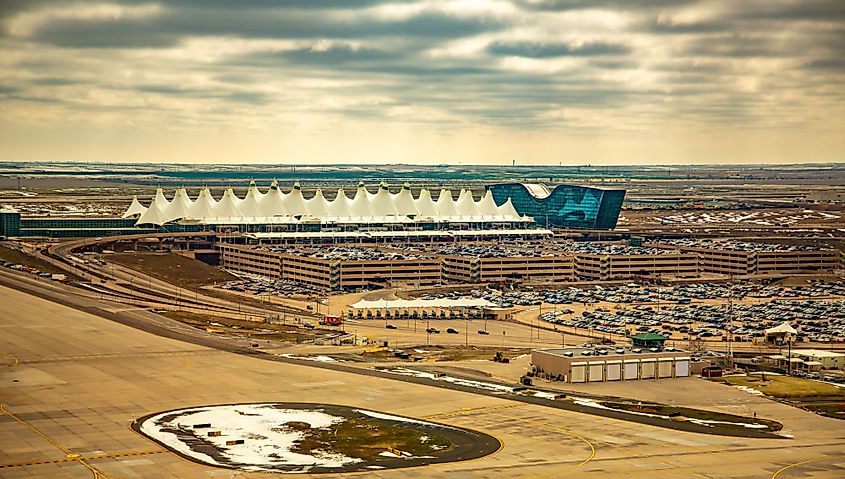
Denver International Airport (DEN) is the Western Hemisphere's largest airport by land area (33,531 acres) and sits 25 miles northeast of downtown. Opened in 1995, it recorded 695,000 aircraft movements in 2024, ranking as the third-busiest in the U.S. and sixth worldwide. Six widely spaced runways, including 16R/34L at 16,000 ft, the continent's longest, enable reliable operations in Denver's mile-high altitude and winter storms. The single Jeppesen Terminal feeds three concourses with 169 gates and a driverless train; a $4 billion expansion will raise capacity toward 100 million. United operates its largest hub here, joined by major bases for Southwest and Frontier, offering 231 global nonstop destinations across continents and fueling Colorado's $47 billion annual aviation economy.
4. O'Hare International Airport
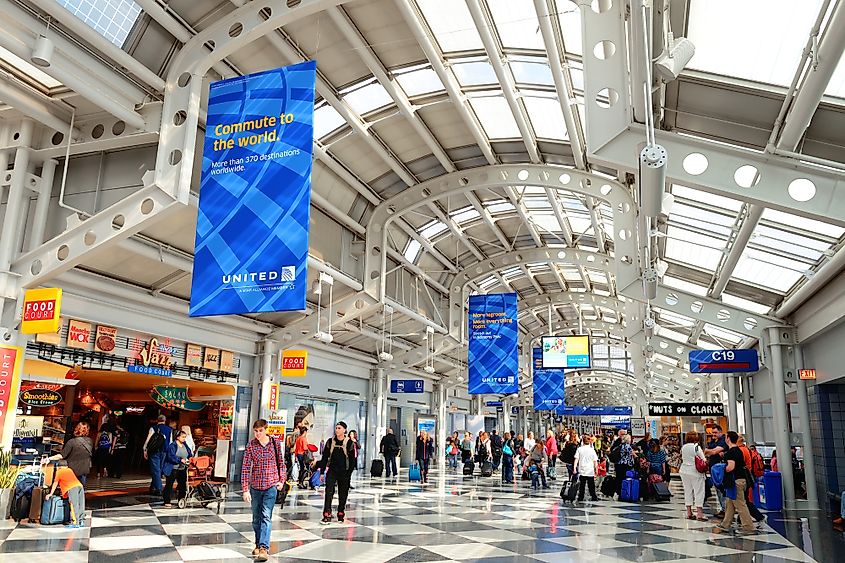
Chicago O'Hare International Airport (ORD) spans 7,627 acres on the city's northwest side, 17 miles from the Loop. In 2024, it handled 776,000 aircraft movements and 2.07 million tons of cargo, ranking fourth-busiest globally and third in the US. O'Hare offers nonstop service to 249 destinations, making it America's most connected airport. It also serves as a twin mega-hub for the United States and America, plus sizeable Frontier and Spirit bases. Eight runways, six parallel after the $6 billion airfield modernization, support intense operations; an $8.5 billion "O'Hare 21" program will add a Global Terminal, two satellite concourses, and 50 additional gates by 2030. Pioneering jet-age design, CTA Blue Line rail, and Interstate 190 keep the Midwest super-connector moving efficiently each day.
5. Los Angeles International Airport
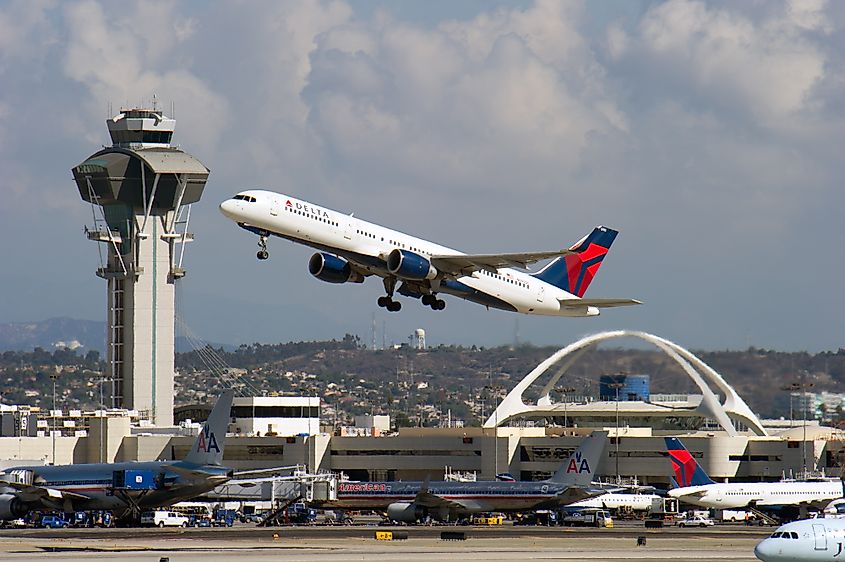
Los Angeles International Airport (LAX) anchors U.S. West Coast aviation, handling 2.4 million tons of cargo in 2024. The 3,500-acre field in Westchester, 18 mi southwest of downtown, operates four parallel runways and 161 gates across nine terminals, framed by the 1961 "Theme Building." LAX is the world's busiest origin-and-destination airport, about 88% of travelers start or end journeys here, and the nation's top Pacific gateway, offering non-stops to 92 international cities. It serves as a hub or base for eight passenger carriers, plus major cargo operators. A $30 billion modernization drive is adding the Midfield Satellite Concourse, Terminals 0 and 9, a consolidated RENT-A-CAR center, and a 2.25-mile automated people mover linking rail, parking, and terminals by 2026 ahead of the 2028 Los Angeles Olympic Games event.
6. John F. Kennedy International Airport
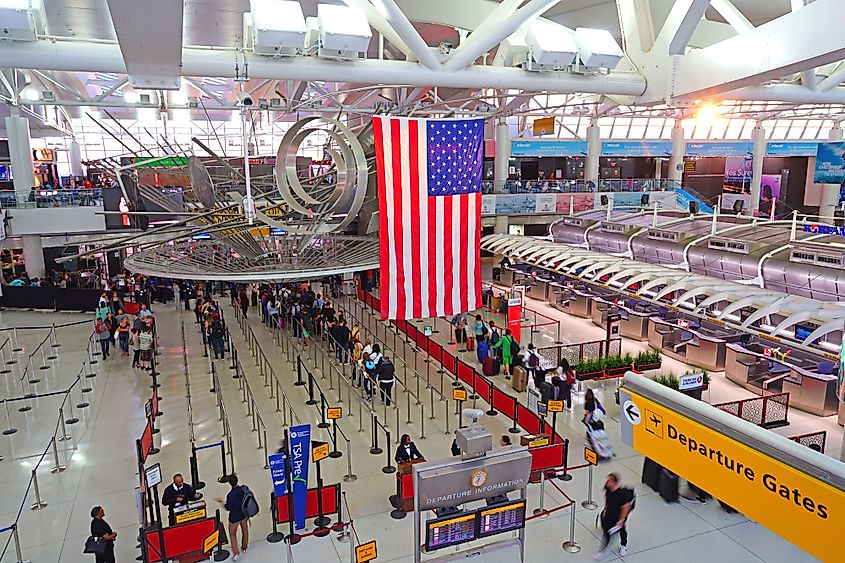
John F. Kennedy International Airport (JFK), on Jamaica Bay in Queens, is New York City's global gateway and North America's busiest international airport. Spanning 5,200 acres with four long runways, JFK handled 1.67 million tons of cargo in 2024, ranking sixth nationwide by traffic. Five terminals host more than 90 airlines, led by Delta, JetBlue, and American, and offer nonstop service to all six inhabited continents. Ongoing $19 billion redevelopment is replacing Terminals 1 and 2 with a 2.4 million-ft2. New Terminal 1, expanding Terminal 4 for Delta, and adding a 10-gate Terminal 6 for JetBlue, all linked by AirTrain and new roadways. The airport is owned by the Port Authority of New York and New Jersey. The complex supports 24/7 customs, extensive cargo facilities, and the landmark TWA Hotel inside Saarinen's Flight Center.
7. Charlotte Douglas International Airport
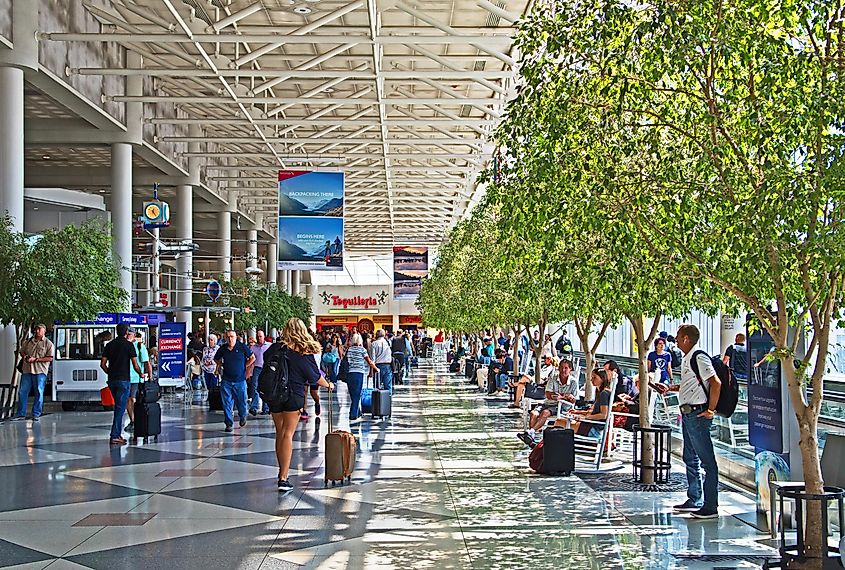
Charlotte Douglas International Airport (CLT) lies six miles west of downtown Charlotte, North Carolina. Opened in 1935, the 5,558-acre field has grown into American Airlines' second-largest hub and one of the nation's busiest transfer points. In 2024, CLT handled nearly 600,000 aircraft movements, ranking seventh in the U.S. for traffic. A single terminal houses 124 gates across five concourses; Concourse E alone supports the world's largest regional-jet operation. Three parallel north-south runways (10,000-ft, 9,000-ft, and 8,676-ft) accommodate simultaneous arrivals, while a fourth parallel 10,000-ft strip is under construction for 2027. The $2.5 billion "Destination CLT" program is expanding the lobby, concourses, and roadway, and light-rail and people-mover links are planned for the 2030s to handle future passenger demand.
8. Harry Reid International Airport
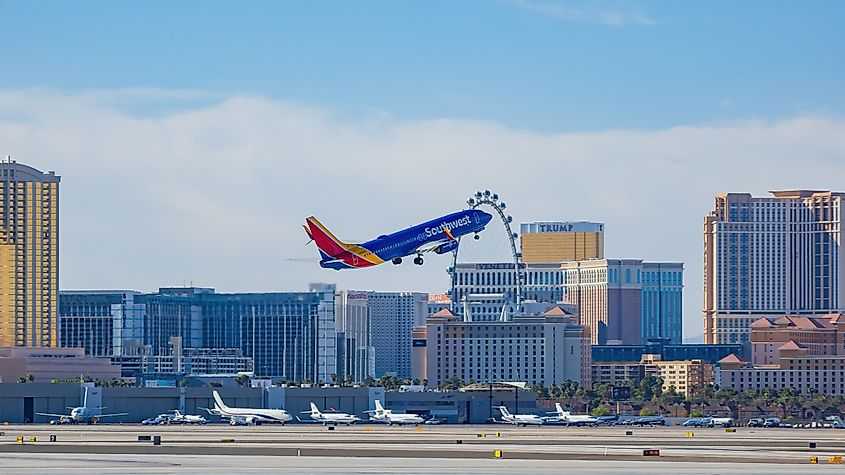
Harry Reid International Airport (LAS) is the nation's primary gateway to the Las Vegas Strip, sitting five miles south of downtown in Paradise, Nevada. The Clark-County-owned facility covers 2,800 acres and fields four concrete runways, including 8L/26R at 14,515 ft, America's third-longest commercial strip. Two terminals and satellite Concourse D provide 110 gates linked by an airside tram; Terminal 3 handles all international arrivals. In 2024, LAS welcomed a record 614,000 aircraft movements, ranking eighth domestically. Southwest is the dominant carrier, joined by bases for Allegiant, Frontier, Spirit, and JSX; long-haul links stretch to London, Amsterdam, Seoul, and Panama City. Known for pioneering common-use kiosks, baggage tracking, and slot machines, the airport was renamed for U.S. Senator Harry Reid in 2021.
9. Orlando International Airport
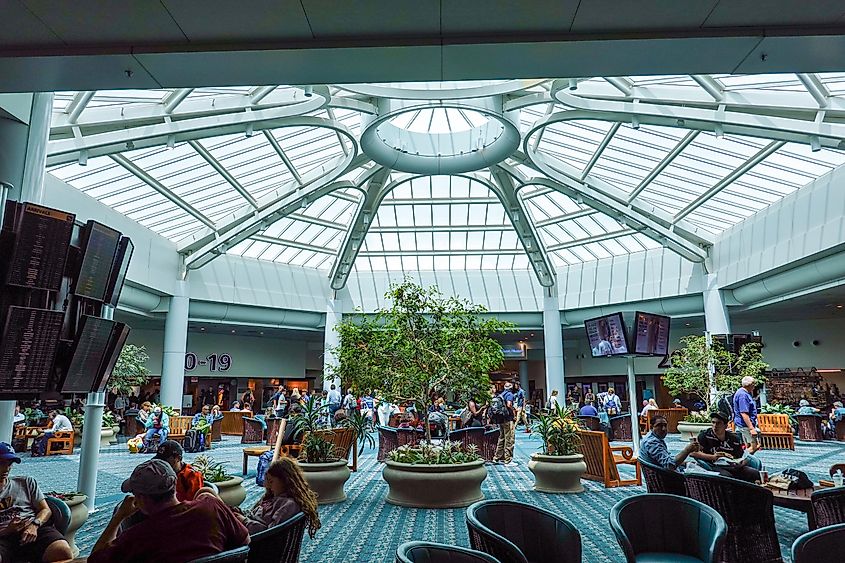
Orlando International Airport (MCO) lies six miles southeast of downtown and occupies 11,605 acres on the former McCoy Air Force Base; its code recalls that heritage. Four 9,000-12,005 feet runways and a terminal complex handle heavy traffic. Two linked landslide halls feed four Airsides (1-4), while the $2.8 billion South Terminal C opened in 2022, bringing total gates to 129 and connecting to Brightline rail. MCO is the largest base for Southwest and an operating base for Breeze, Frontier, and Spirit, with JetBlue as a focus city; 40-plus airlines link more than 170 destinations, from Emirates' Dubai nonstop to Virgin Atlantic's Heathrow flights. Planned Terminal D will raise capacity to 100 million.
10. Miami International Airport
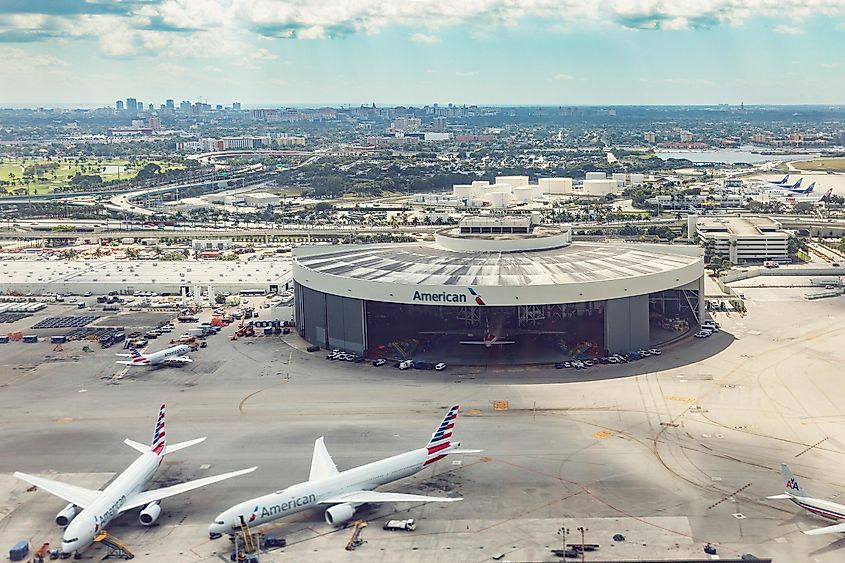
Miami International Airport (MIA) sprawls over 3,300 acres, eight miles west-northwest of downtown. It moves nearly 3 million tons of cargo a year, making it Florida's busiest airport and America's top gateway to Latin America and the Caribbean. Four asphalt runways and a tri-terminal, six-concourse layout (131 gates) support more than 1,000 daily flights to 185 destinations worldwide. American Airlines controls over half the traffic, operating its primary south-bound hub, while major cargo operators such as FedEx, UPS, Amazon, LATAM Cargo, and DHL drive the nation's largest international freight throughput. Record growth has triggered a 15-year, $5 billion capital program, concourses optimized, hotels added, Concourse G razed, cargo capacity doubled, to prepare MIA for 77 million passengers by 2040.
The Busiest Airports in the US by Passenger Traffic
| Rank | Airport | Major Cities | State | Passenger Enplanements |
|---|---|---|---|---|
| 1 | Hartsfield-Jackson Atlanta International Airport | Atlanta | GA | 52,511,402 |
| 2 | Dallas Fort Worth International Airport | Dallas and Fort Worth | TX | 42,351,316 |
| 3 | Denver International Airport | Denver | CO | 40,012,895 |
| 4 | O'Hare International Airport | Chicago | IL | 38,575,693 |
| 5 | Los Angeles International Airport | Los Angeles | CA | 37,760,834 |
| 6 | John F. Kennedy International Airport | New York City | NY | 31,201,170 |
| 7 | Charlotte Douglas International Airport | Charlotte | NC | 28,523,822 |
| 8 | Harry Reid International Airport | Las Vegas | NV | 28,183,403 |
| 9 | Orlando International Airport | Orlando | FL | 27,859,783 |
| 10 | Miami International Airport | Miami | FL | 26,588,002 |
| 11 | Phoenix Sky Harbor International Airport | Phoenix | AZ | 25,595,723 |
| 12 | Seattle-Tacoma International Airport | Seattle and Tacoma | WA | 25,414,592 |
| 13 | San Francisco International Airport | San Francisco | CA | 25,078,968 |
| 14 | Newark Liberty International Airport | Newark and New York City | NJ | 24,313,706 |
| 15 | George Bush Intercontinental Airport | Houston | TX | 23,349,157 |
| 16 | Logan International Airport | Boston | MA | 21,090,721 |
| 17 | Minneapolis-Saint Paul International Airport | Minneapolis and Saint Paul | MN | 18,054,481 |
| 18 | Fort Lauderdale-Hollywood International Airport | Fort Lauderdale and Hollywood | FL | 17,096,131 |
| 19 | LaGuardia Airport | New York City | NY | 16,715,567 |
| 20 | Detroit Metropolitan Airport | Detroit | MI | 16,110,696 |
| 21 | Philadelphia International Airport | Philadelphia | PA | 15,102,261 |
| 22 | Salt Lake City International Airport | Salt Lake City | UT | 13,543,570 |
| 23 | Baltimore/Washington International Airport | Baltimore and Washington, D.C. | MD | 13,221,461 |
| 24 | Dulles International Airport | Washington, D.C. | VA | 13,002,433 |
| 25 | San Diego International Airport | San Diego | CA | 12,780,013 |
| 26 | Ronald Reagan Washington National Airport | Washington, D.C. | VA | 12,750,892 |
| 27 | Tampa International Airport | Tampa | FL | 12,075,591 |
| 28 | Nashville International Airport | Nashville | TN | 12,057,435 |
| 29 | Austin-Bergstrom International Airport | Austin | TX | 10,676,243 |
| 30 | Daniel K. Inouye International Airport | Honolulu | HI | 10,449,022 |
Data gathered from the FAA Preliminary 2024 Enplnament report
